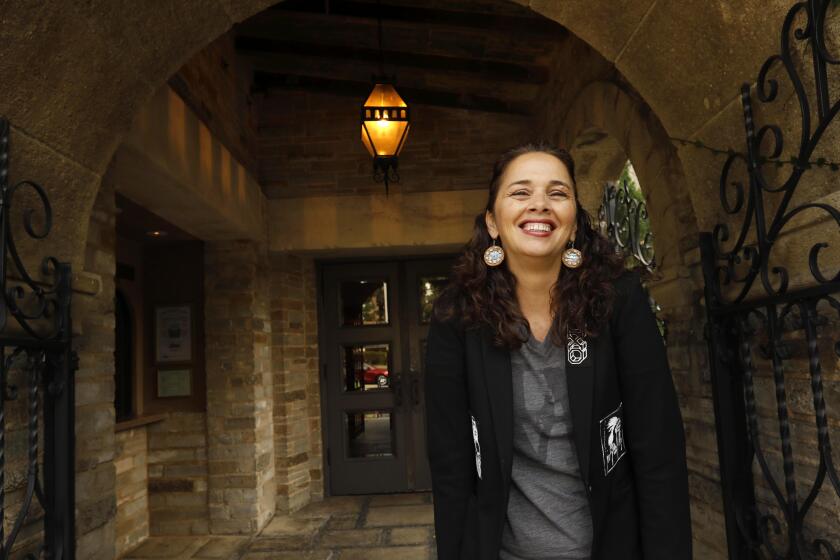NEA: Vital Link Between Society and Art
The letter arrived. The National Endowment for the Arts had written my organization, The Bill T. Jones/Arnie Zane Dance Co., informing us we had again been included among the funded applicants.
At first, there was immense relief; we no longer feared we had been “dropped”--the term whispered and shouted throughout a field threatened by the 40% cut to the NEA’s already emaciated budget. (From $162.3 million in 1995 to $99.5 million for 1997.)
With relief came a vague and redeeming sense that the “imprimatur” of NEA funding still existed, if perhaps faintly. To be honest, the amount we were awarded is modest, taking into account our budget, but the “imprimatur” is good for morale in a starkly demoralized art climate. And this “pat on the back” sends an important signal to agencies in the private sector that investment in our organization is worthwhile.
The NEA was created by Congress as an independent government agency to support the arts and provide education and access to the arts for all Americans. Its mission: to foster the excellence, diversity and vitality of the arts in the U.S. and broaden public access to them.
Artists create and flourish in an atmosphere friendly to creativity. The spirit informing the creation of the NEA was rooted in a belief that enlightened governance strives to reduce adversity and struggle in the lives of its constituents, providing a mechanism that offers the widest number of individuals access to the vital domain of art. This domain provides intellectual stimulation, an opportunity for deep contemplation. More pragmatically, it was also rooted in the age-old awareness that a great nation’s culture is its most radiant ambassador.
The NEA’s history reveals it has been successful in its mission. Since 1965, the NEA was instrumental in the establishment of public arts agencies in every state, as well as seven regional service organizations. Through partnerships, the NEA helped increase the amount of private donations to the arts: For every dollar from the endowment, other sources contributed $12 to make art happen in thousands of communities. Millions of children received formal arts education in public schools, helping improve their overall performance. More people than ever had the opportunity to see first-rate arts events in their communities--attendance now surpasses that of professional sports events.
What are we to make of the misfortune of such a successful, well-run organization? Is it the inexorable corrosion of time eating away at the idealism of the 1960s? Is it the maturation process in the consciousness of Congress that has seen the budget for this important endeavor go from a barely acceptable $176.2 million in 1992--by the standards of most Western nations of which we see ourselves as leader--to a meager amount this year.
Even with its drastic cuts, the NEA remains the largest, single funder of arts organizations. But that 40% budget cut has sent a struggling field reeling.
With considerable heat and all too little light, the NEA is castigated. Its more vociferous critics, declaring the organization unneeded, have sworn to destroy it.
But do I need the NEA? Yes!
Would I stop making choreography and cease struggling to maintain my company without its encouragement? No!
For me, the making of art performs a function similar to that of traditional religion. Live performance--particularly performances not created for profit--is essential for a balanced culture. To see a live performer reminds us that we are not simply trapped inside a fleshy vessel careening from the shock of birth to the uncertainty of death. We are capable of what great music is capable of, of what pure thought strives for--yet, we are also gloriously human. Yes, I will continue to strive, but the support of the NEA, born of high hope and a basic belief in our potential, builds a vital bridge between the anonymous, elusive concept we name society and a class of alienated individuals, like myself, called artists.
The NEA arranges a sort of contract between society and artists. I respect this contract. The NEA acts as the public’s representative, making an award to me as a choreographer and my organization as a group of dedicated professionals, saying “take this and do your best.” I accept the award and strive to create something meaningful, perhaps beautiful. The dance company becomes a microcosm of human experience. A dance concert is, at once, an entertainment, a diversion, a lesson and an exercise in community.
Can I, as an artist, give any guarantees as my part of the contract? Bessie Schoenberg, a venerated teacher who has guided several generations of choreographers and after whom the New York dance and performance awards takes its name, once exhorted a Bessie Awards audience with the challenge to be “outrageous.” I don’t think she meant artists should resort to facile tactics of shock or titillation. She was urging us to ask ourselves hard questions and then, with our most rigorous intellect, intuition, discipline and passion, to join in the confounding discourse we call living.
Most of the time, artists can only guarantee they will present what their gut tells them is beautiful and true; nothing more. And this is the rub.
Ironically, it is the minuscule part of the NEA’s giving in support of individuals that has given the organization its biggest headache. A handful of artists or works by such artists caught the attention of persons in public office suspicious of diverse views of our bodies, our lifestyles, our beliefs. These works created a convenient pretext, which was ultimately political, for annihilating an organization whose very existence is an indication of our society’s health. In a humiliating attempt to appease these critics, the NEA obliterated its support to individuals.
The other tactic, so popular with those who disagree with the idea that the NEA is as important as health care, education or defense, is the fiscal-austerity argument. Its essence is that our government cannot support such a frivolous endeavor as the arts at this time. But just compare our military budget, with its much-publicized waste, with the NEA’s allotment that, even in the best of times, was lacking--and yet succeeded brilliantly in its mission. Like the military, the arts create jobs and a sense of stability and tradition when they are allowed time to put down roots and grow in the soil of our culture.
The arts do something else as well: They provide a vision of a world that is free in the truest sense. Free to disagree with ideology, commonly held beliefs, history and even itself. Yet, at the heart of this vision is a sincere belief in humankind and its questions.
In a country of immigrants, many of whom continue to pass through the fires of adversity, a sentimental metaphor is in order. What of the parent who manages to feed his or her family when there is barely enough to eat, and somehow the children grow strong and soulful? Imagine if this resourceful provider was given adequate means, what those children could become?
“Under the arc of the sky they are unsafe,” the poet says. Perhaps so, but with a more enlightened Congress, a better-informed public and the care and guidance of “our great idea,” the NEA, we can say, “we are not afraid.”
More to Read
The biggest entertainment stories
Get our big stories about Hollywood, film, television, music, arts, culture and more right in your inbox as soon as they publish.
You may occasionally receive promotional content from the Los Angeles Times.





